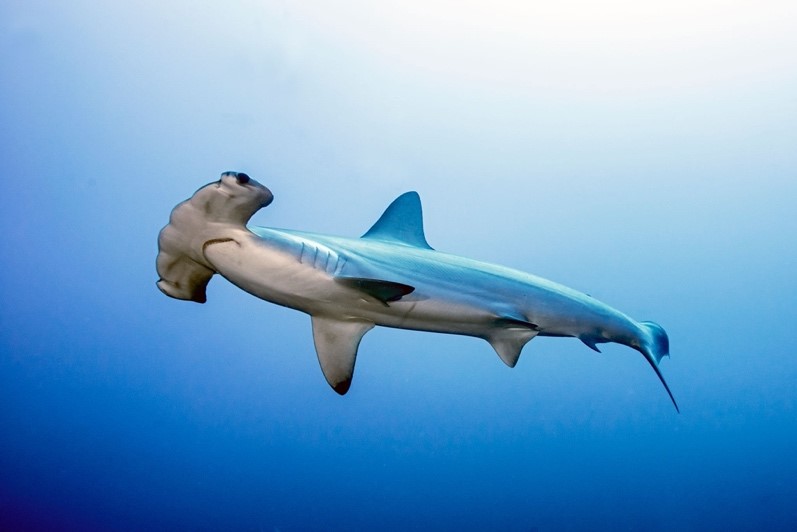Description
 Disclaimer: Copyright infringement not intended.
Disclaimer: Copyright infringement not intended.
Context
- Hammerhead sharks can hold their breath to survive almost freezing-cold waters during deep dives, a study has found.
Details
- The study found scalloped hammerhead sharks are able to conserve their body temperature while diving over 2,500 feet under the surface to hunt for deep-sea prey.
- The scientists who led the study believe the sharks do so by clamping their gills shut to avoid cold water coming into their bodies, a never-before-seen survival strategy.
- That means the sharks are essentially holding their breath for around 17 minutes while hunting.
- Hammerhead sharks are exothermic animals, meaning that they have no internal way to control their body temperature
Survival strategy
- Swimming in the right temperature water can be a matter of life and death for these animals because their metabolism, brain, vision, and muscles start slowing down if they get too cold.
- And if these sharks can't swim, they suffocate.
- Study found the sharks were able to conserve their body temperature almost throughout the dive, their internal temperature dropping only when the sharks are nearer the surface.
- Because sharks can't regulate their body temperature, any cold water coming through their gills immediately cools the body.
- So the solution to keeping warm amid frigid waters is to keep the gills tightly shut.
- The team's data suggests that the sharks close their gills before shooting almost vertically downward. They only open their gills once again about 1000 feet below the surface, when they slow their upwards ascent to catch their breath.

About Great Hammerhead Shark
- Scientific Name: Sphyrna mokarran
- Distribution: Worldwide in tropical waters
- Ecosystem/Habitat: Coastal to open ocean (pelagic)
- Feeding Habits: Aggressive predator
- Taxonomy: Class Chondrichthyes, Order Carcharhiniformes (Ground sharks), Family Sphyrnidae (Hammerhead sharks)
Key Facts
- The great hammerhead shark is the largest of all hammerhead species, reaching a maximum known length of 20 feet.
- The species is distinguished from other hammerheads by its nearly straight hammer-shaped head that has a prominent indentation in the middle.
- Like other hammerhead species, great hammerhead sharks have long, serrated teeth and use their hammer-shaped heads to detect and eat prey.
- Great hammerheads are vulnerable to overfishing. They are caught incidentally and commercially targeted for their valuable fins in longline, bottom trawl, gillnet and hook-and-line fisheries.
- Great hammerhead sharks are believed to be cannibalistic, eating their own species if need be.

About Shark
- Sharks are predatory fish with streamlined bodies adapted for fast swimming.
- They have cartilaginous internal skeletons and belong in the Class: Chondreicthyes.
- Their teeth are not attached to jaws but arranged in rows which are embedded in the gum.
- Their skeleton is made up of cartilages and connective tissue, but not bones.
- Also, sharks do not have a rib cage as in most of the vertebrates.
- Sharks are cold-blooded animals but, they are able to keep warmer blood around eyes and brain through circulatory mechanisms.
- Their digestion is different from the other fish as the food is stored in the stomach and unwanted materials are thrown out through mouth by turning the stomach inside out.
- Sharks have an excellent sense of smell and a good vision.
- Additionally, they are electro receptive and they can also sense the environment from their lateral line.
- They are solitary hunters and can swim about eight kilometres without resting at a higher speed.
- Usually, a shark lives about 20 to 30 years.
About Whale
- Whales are gigantic marine mammals of Order: Cetacea.
- The blue whale is the largest animal on the Earth.
- Being mammals, they are warm-blooded.
- They nourish their young with nutritious milk produced in mammary glands.
- Their skin is covered by hair and there is a fat layer beneath the skin functioning in thermoregulation, buoyancy, and as an energy store.
- Whales have a four chambered heart and they breathe through blow holes. Interestingly, males are called bulls and females called cows.
- The other important feature is that whales take rests but they never sleep.
- They could be either predators (e.g. Killer whale) or filter feeders.
- Whales are long lived mammals with a lifespan of 70 – 100 years.
|
Differences between Shark and Whale
- Sharks are fish and cold-blooded, whereas whales are warm-blooded mammals.
- Sharks have a cartilaginous skeleton, but it is a bony skeleton in whales.
- Whales are generally larger in body size than sharks.
- Whales have lungs sharks have gills for breathing.
- The body of the whale is covered with hair but shark has dermal denticles covering the skin.
- The teeth are fixed in the dental arch in whales, whereas sharks have teeth arranged in rows and fixed in the gum.
- Sharks sleep, but whales only rest.
- Whales nourish the newborns by milk secreted by mammary glands, but sharks do not.
- Whales have thick fat layer beneath the skin, but sharks have oil-filled liver for buoyancy.
- Whales live longer than sharks.
- The whales have developed ears, but sharks have excellent senses of smell, vision, and electro receptiveness.
|

|
PRACTICE QUESTION
Q) Which of the following statements with reference to Sharks is/are correct?
1. Sharks are gigantic marine mammals of Order Cetace.
2. Sharks are cold-blooded.
3. Sharks sleep, but whales only rest.
- 1 and 2
- 2 and 3
- 1 and 3
- 1, 2 and 3
Correct Answer: 1
|
https://www.businessinsider.in/science/news/hammerhead-sharks-hold-their-breath-when-deep-diving-up-to-2500-feet-to-avoid-freezing-to-death/articleshow/100168217.cms





 Disclaimer: Copyright infringement not intended.
Disclaimer: Copyright infringement not intended.





